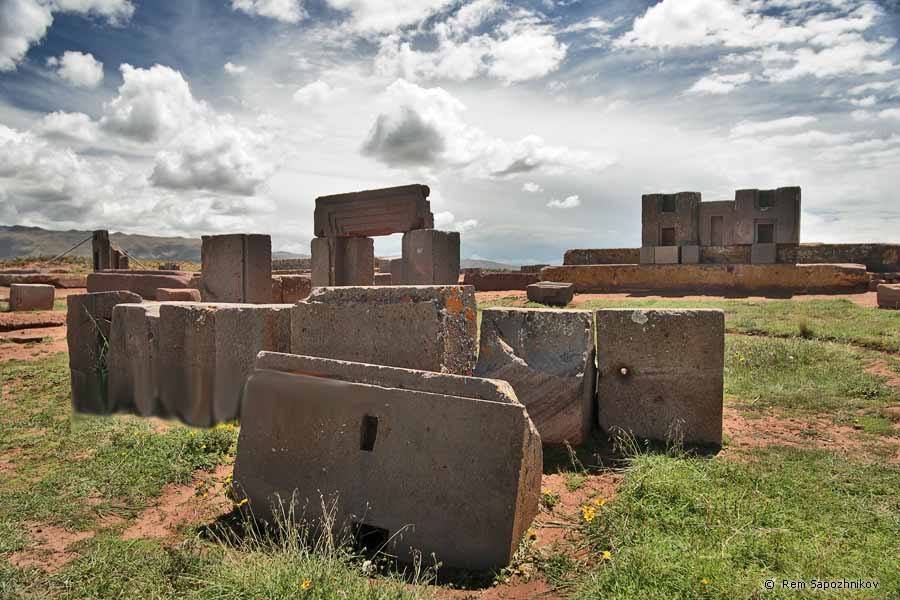
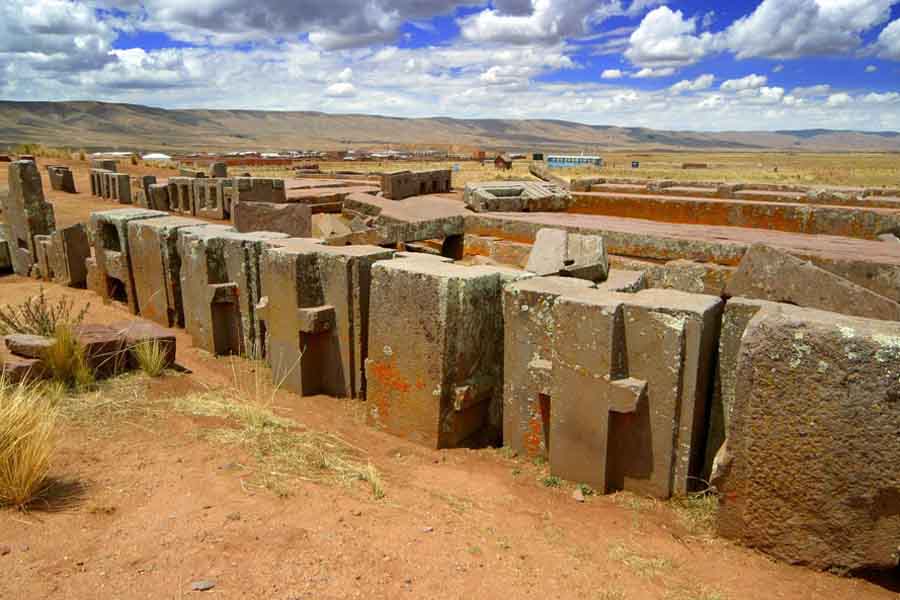




Puma Punku is one of the most enigmatic megalithic sites on the planet - linked with extraterrestrials or those who were here before the current human experiment.
For decades, researchers have been trying to discover what the original structures looked like and how the giant pieces fit together ... using computer technology, creating the site in movable pieces that look like Legos, on site visits, and more.
Technically, they could not have been crafted by early humans so therefore their origins have yet to be discovered if ever.
Megalithic structures of unknown origins are found across the planet with overlapping geometric designs. Some have powerful energy that align with human consciousness as an aid to remember that we are nothing more than inserts having a physical experience that is ending. This is in fact a virtual reality experiment that your brain tells you is real, but is an illusion programmed for emotions not intellect using perhaps 10% - of the brain.
Did ancient civilizations or alien visitors understand more about creation than modern day humans? I don't know the answer to that. It may vary meaning all of what we believe once happened actually never did.
Human memories are genetically suppressed. Remembering equates to putting the pieces of a puzzle together much like the megalithic blocks at Puma Punku and elsewhere.
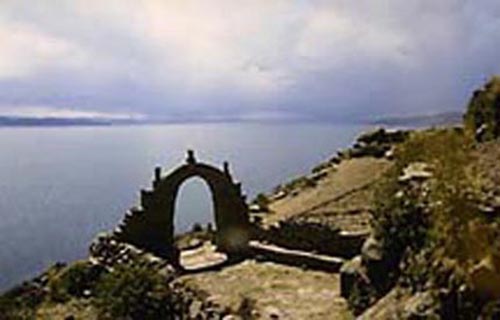
Puma Punku is situated near the south eastern shore of Lake Titicaca and sits on a plateau in the Andes at roughly 12,600 feet elevation.
Puma Punku's construction is generally argued to have taken place beginning around 200 BC. The temple itself stood at least 56 feet tall and took up an area of 164 square feet while the overall site and the surrounding constructions, namely the pyramid which the ruins sit on, extend over half a kilometer in length.
At its peak, Puma Punku is thought to have been unimaginably wondrous, adorned with polished metal plaques, brightly colored ceramic and fabric ornamentation, and trafficked by costumed citizens, elaborately dressed priests and elites decked in exotic jewelry.
Understanding of this complex is limited due to its age, the lack of a written record, and the current deteriorated state of the structures due to looting, stone mining for building stone and railroad ballast and natural weathering. The technological innovation and the beautiful stonework that went into the creation of Puma Punku have drawn comparisons to the Egyptian pyramids, Stonehenge and Easter Island.
Determining the age of these ruins has been a focus of researchers since the site's discovery. Currently archaeologists date the beginning of the Tiwanaku culture to some time around 1500 BC, and the construction of the Puma Punku complex to around 200 BC.
Previously, in the early 1900s, Bolivian engineer Arthur Posnansky, based on astronomical alignments, concluded that Tiwanaku was constructed as early as 15,000 BC (17,000 BP), possibly even older and was not an original construction of the Tiwanaku.
In the 1930s, German astronomers from the University of Bonn; Rolf Muller, Hanns Lundendorff, Friederich Becker, and Arnold Kohlshutter came to conclusions similar to Posnansky's estimate. However, as noted by Kolata subsequent archaeological research has found a complete lack of any physical evidence, including prehistoric tools and dated midden deposits, for any occupation of the Tiwanaku site as old as argued by Posnansky and the German astronomers either at the Tiwanaku Site, near it, or in direct association with the Puma Punku complex despite decades of intensive excavation and research.
The processes and technologies involved in the creation of these temples are still not fully understood by modern scholars. Our current ideas of the Tiwanaku culture hold that they had no writing system and also that the invention of the wheel was most likely unknown to them.
The architectural achievements seen at Puma Punku are striking in light of the presumed level of technological capability available during its construction. Due to the monumental proportions of the stones, the method by which they were transported to Puma Punku has been a topic of interest since the temple's discovery.
The stones are argued to have been transported up a steep incline from a quarry near Lake Titicaca roughly 20 miles away. Some of the blocks are said to weigh in the range of 100–130 tons.
One notable block has been measured at 36 feet long, 16 feet wide and 6 feet thick. Archaeologists argue that this was accomplished by the large labor force of ancient Tiwanaku. Several theories have been proposed as to how this labor force transported the stones although these theories remain speculative. Two of the more common proposals involve the use of llama skin ropes and the use of ramps and inclined planes.
In assembling the walls of Puma Punku, each stone was finely cut to interlock with the surrounding stones and the blocks fit together like a puzzle, forming load-bearing joints without the use of mortar. One common engineering technique involves cutting the top of the lower stone at a certain angle, and placing another stone on top of it which was cut at the same angle.
The precision with which these angles have been utilized to create flush joints is indicative of a highly sophisticated knowledge of stone-cutting and a thorough understanding of descriptive geometry.
Many of the joints are so precise that not even a razor blade will fit between the stones.
Much of the masonry is characterized by accurately cut rectilinear blocks of such uniformity that they could be interchanged for one another while maintaining a level surface and even joints.
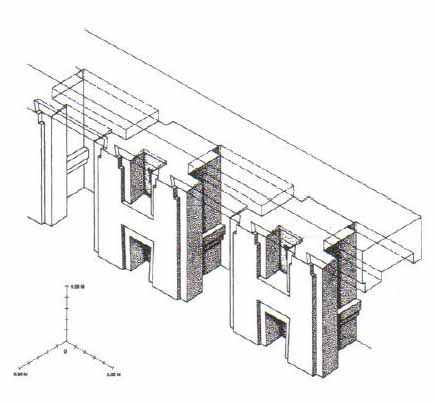
The blocks were so precisely cut as to suggest the possibility of prefabrication and mass production, technologies far in advance of the Tiwanaku's Incan successors hundreds of years later.
Tiwanaku engineers were also adept at developing a civic infrastructure at this complex, constructing functional irrigation systems, hydraulic mechanisms, and waterproof sewage lines.
To sustain the weight of these massive structures, Tiwanaku architects were meticulous in creating foundations, often fitting stones directly to bedrock or digging precise trenches and carefully filling them with layered sedimentary stones to support large stone blocks.
Modern day engineers argue that the base of the Puma Punku temple was constructed using a technique called layering and depositing. By alternating layers of sand from the interior and layers of composite from the exterior, the fills would overlap each other at the joints, essentially grading the contact points to create a sturdy base.
Notable features at Puma Punku are I-shaped architectural cramps, which are composed of a unique copper-arsenic-nickel bronze alloy. These I-shaped cramps were also used on a section of canal found at the base of the Akapana pyramid at Tiwanaku.
These cramps were used to hold the blocks comprising the walls and bottom of stone-line canals that drain sunken courts. I-cramps of unknown composition were used to hold together the massive slabs that formed Puma Punku's four large platforms.
In the south canal of the Puma Punku, the I-shaped cramps were cast in place. In sharp contrast, the cramps used at the Akapana canal were fashioned by the cold hammering of copper-arsenic-nickel bronze ingots.The unique copper-arsenic-nickel bronze alloy is also found in metal artifacts within the region between Tiwanaku and San Pedro de Atacama during the late Middle Horizon around A.D. 600-900.
The Puma Punku is another man-made platform built on an east-west axis like the Akapana. Its main difference from other structures at the cite is its T-shaped construction. It measures 150 meters on each side and 5 meters tall. The heaviest stone block weighs 131 tons and was dragged from a quarry 10 km away. One of the sunken temples includes projecting heads of volcanic tuff which may imply remote Chavin influence.
It is theorized the Puma Punku complex as well as its surrounding temples, the Akapana pyramid, Kalasasaya, Putuni and Kerikala functioned as spiritual and ritual centers for the Tiwanaku. This area might have been viewed as the center of the Andean world, attracting pilgrims from miles away to marvel in its beauty.
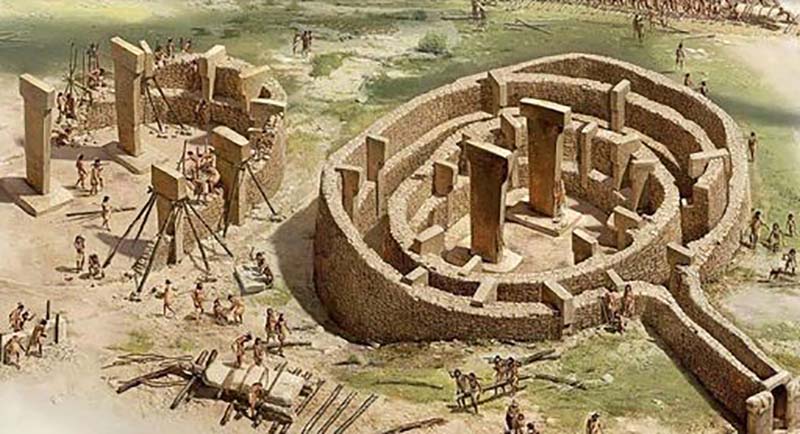
Gobekli Tepe in Turkey
Putting the Pieces the Puzzle Together